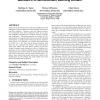Free Online Productivity Tools
i2Speak
i2Symbol
i2OCR
iTex2Img
iWeb2Print
iWeb2Shot
i2Type
iPdf2Split
iPdf2Merge
i2Bopomofo
i2Arabic
i2Style
i2Image
i2PDF
iLatex2Rtf
Sci2ools
109
click to vote
GECCO
2006
Springer
2006
Springer
Comparing evolutionary and temporal difference methods in a reinforcement learning domain
Both genetic algorithms (GAs) and temporal difference (TD) methods have proven effective at solving reinforcement learning (RL) problems. However, since few rigorous empirical comparisons have been conducted, there are no general guidelines describing the methods' relative strengths and weaknesses. This paper presents the results of a detailed empirical comparison between a GA and a TD method in Keepaway, a standard RL benchmark domain based on robot soccer. In particular, we compare the performance of NEAT [19], a GA that evolves neural networks, with Sarsa [16, 17], a popular TD method. The results demonstrate that NEAT can learn better policies in this task, though it requires more evaluations to do so. Additional experiments in two variations of Keepaway demonstrate that Sarsa learns better policies when the task is fully observable and NEAT learns faster when the task is deterministic. Together, these results help isolate the factors critical to the performance of each metho...
Related Content
| Added | 23 Aug 2010 |
| Updated | 23 Aug 2010 |
| Type | Conference |
| Year | 2006 |
| Where | GECCO |
| Authors | Matthew E. Taylor, Shimon Whiteson, Peter Stone |
Comments (0)

